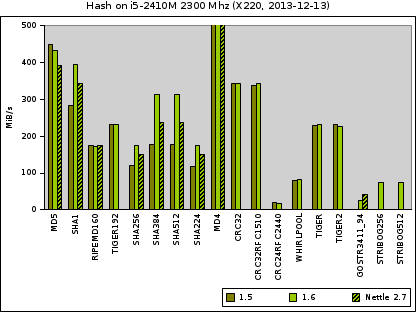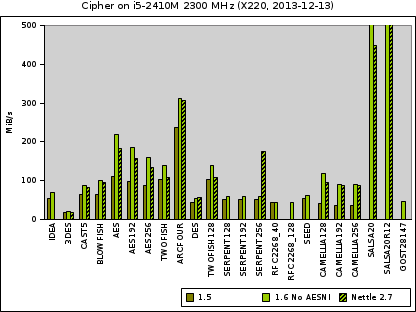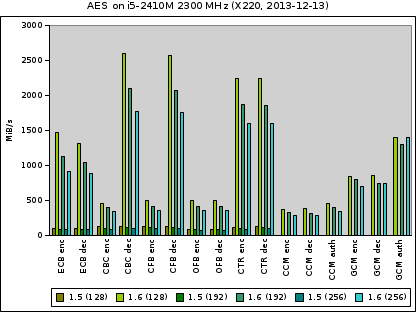Speedups in Libgcrypt 1.6
Posted 15th December 2013 by Werner Koch
Libgcrypt is a building block of modern GnuPG versions (GnuPG 2.x) and also used by a wide range of other projects. In fact all Linux distributions install Libgcrypt by default.
One problem with Libgcrypt has always been that it did not deliver top performance compared to OpenSSL. Even another GNU crypto library, Nettle, is in some areas faster. The reason for this is that Libgcrypt was based on an old GnuPG version. Back in the 1990s performance was not the first aim for free crypto software. The crypto authors haved been treated as arms trafficker in the US and not allowed to freely distribute their code. Thus the primary goal was to write free crypto code in one of the free countries. Further, patents severely hindered the use of crypto algorithms. This together may explain why top performance was not an issue at that time. Over the years this changed to the better. However, free software development is mostly driven by user demand and there was not much demand for a faster GnuPG. Thus we did not care much on speeding up Libgcrypt. Well, basic support for VIA and Intel CPU accelerated encryption features was eventually added but still lots of other things could have been optimized.
Last year, Jussi Kivilinna joined the team and started to add CPU optimized implementations of common cipher algorithms. This changed the picture for cipher and hash algorithms. The soon to be released Libgcrypt 1.6 is now up to modern standards on what can be achieved on general purpose CPUs.
To check how 1.6.0 will compare to the older 1.5 version of Libgcrypt, I did some benchmarks using a Thinkpad X220 which features an i5-2410M processor at 2.3GHz running a 64 bit Debian Wheezy. Default compiler options have been used.
First let us see how hash algorithms compare (click to enlarge):
The olive bars indicate how many bytes can be hashed by version 1.5.3, the green bar gives the figure for the new 1.6.0, and finally for some algorithms the hatched bar to what Nettle 2.7 is up to.
The number for the completely insecure MD4 algorithms is way to high (~750 MiB/s) to be included in this chart, thus it has been capped. For MD5 the old Libgcrypt is faster. This is a bit surprising but we have not researched the reason; anyway, MD5 shall not be used by today's software because it has been completely broken. For most of the other algorithm the performance figures are all quite similar. For the important SHA-1 algorithm 1.6 gains top speed of all compared implementations and further speedups are expected in future versions.
The major improvements are for SHA-256 and SHA-512 (SHA-384 is a basically SHA-512 with a truncated digest). The use of Intel provided code which utilizes SSSE3 clearly boosts the performance on this machine and probably on a wide range of other modern Intel CPUs.
All hash functions are a target for more optimization in forthcoming versions of Libgcrypt.
Now what about cipher algorithms? Have a look at this chart:
First, you notice that we have a lot of algorithms here. The benchmarks are all done for ECM mode encryption.
There are two extremes here: 3DES is by far the slowest algorithm. It is also the oldest one but still considered rock solid. In the top performance range we see two algorithms: Arcfour (sometimes called RC4), which is a simple, hard to correctly use, and worse broken design which unfortunately is still used at a lot of places. Even outperforming that are the modern Salsa algorithms, which are considered strong and trustworthy. They peak at about 750 MiB/s and 1150 for the reduced round SalsaR12 variant. Both are easy to use stream ciphers.
The Serpent (an AES competition final candidate) and Camellia (preferred in Japan) ciphers are in the same performance range for 1.5 but with the improvements of 1.6 Camellia gets close to the performance of AES under 1.5. Jussi put a lot of work into fine tuning AES in 1.6. Thus even with AES-NI hardware acceleration disabled (as shown here) the throughput for AES encryption has been doubled.
Given that AES is the standard encryption algorithms today, it is worth to have a closer look at AES under different modes of operation.
For each encryption mode you see three groups of bars; one for each cipher size. The first group is for Libgcrypt 1.5, the second for 1.6, and the third for Nettle. Note that only 1.6 implements all modes.
It is quite obvious that the throughput available with 1.6 is way better than with 1.5 and also considerable higher than with Nettle.
Finally we have a look at the performance of AES-NI acceleration:
This time we have no values for Nettle. If you take the different scale in consideration it is quite clear how hardware supported acceleration can boost performance. However, we can‘t be sure whether the CPU has been backdoored to leak key bits.
The actual numbers have been collected using the bench-slope test program from Libgcrypt and the Nettle benchmark. They are available in a Gnumeric spreadsheet.
Jussi did a another set of benchmarks which include figures for OpenSSL; you find them here. He did them using a modified version of a 2008 speedtest comparison. He compared OpenSSL 1.0.1e, Libgcrypt-1.5, Libgcrypt-1.6 (ECB & CTR), and Nettle (2.7.1) on Intel Haswell. Used key sizes were 256 bit or shorter if 256 bit is not supported. Each measurement did a key setup for encryption, the encryption, a key setup for decryption, and the decryption all for different buffer lengths.






